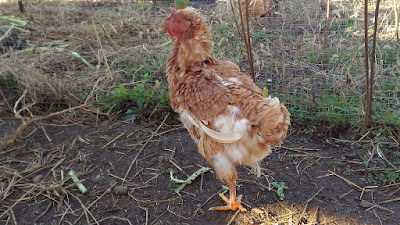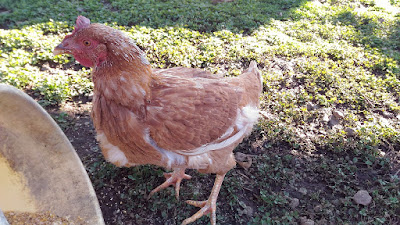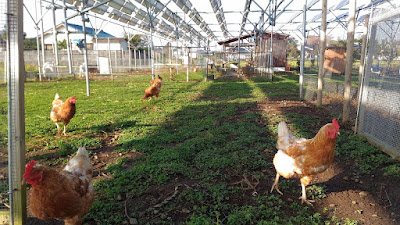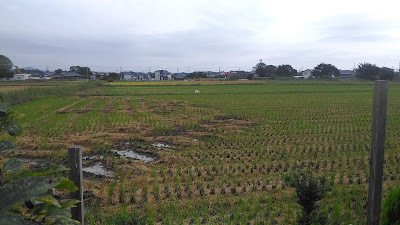This was supposed to be a happy post about our goats
Minto-kun and Akio-kun and their newly found friendship - a sweet, heartwarming story. But yesterday Akio-kun died. How easily a heartwarming story turns into a heartbreaking one. Most of the world doesn't care, but here in the microuniverse of our farm this was a very sad event.
Akio-kun was one of the
triplets that Natchan the Mom brought to the world 7 months ago.
 |
| Akio-kun, standing on the mom's back. April 2016. |
Goats, just like dogs or cats, have a personality. Akio-kun was a happy-go-lucky goat, playfighting with his brother but kind to everyone, both people and goats. He was the one who did not bully Minto-kun when he came to the farm as a malnourished orphaned baby goat. If Akio-kun was a human, he would be the kind of a gentle and easygoing friend that people like to have around.
Whenever I came to the farm, Akio-kun and I had our ritual: He came over to say Hello! and I would give him a bunch of his favorite grass over the fence. His siblings wouldn't bother to come all the way just to say hello to me, but Akio-kun always did. We were friends.
 |
| Akio-kun leaning over the fence, munching on a leafy treat. |
Then in August, Akio-kun left for a new family. The family wanted a goat, so they got Akio-kun. I wasn't happy (I wished the triplets stayed on our farm) but these goats are not ours - we just provide space for grazing - so I have no say in the questions of their fate.
Akio-kun was gone and all I could do was to hope that he was lucky in the lottery of life and got a nice, caring family. Now I have a proof that hoping for the best is the most useless thing in the world.
About two weeks ago Akio-kun came back to the farm. Neighbors of his new "family" complained that he was crying too loud, so the family "returned" him. I wish the neighbors started to complain earlier.
At first I didn't recognized him. In less than two months he changed so much in both appearance and behavior that he was unrecognizable.
I don't know what exactly happened in his new home but Akio-kun looked like he didn't eat and didn't get any attention for two months. He was badly undernourished, with a posture of a shrinking old man, passively standing and barely showing interest in his surroundings.
 |
| Akio-kun, October 12, 2016. |
Natchan the Mom rejected him, and would kick him badly with her horns, so Akio-kun moved in with Minto-kun. That's where the heartwarming story began. Akio-kun and Minto-kun became good friends.
 |
| Grazing together in the back of the farm. |
 |
| At night. Minto-kun squeezed himself into Akio-kun's bed. |
 |
| Together on the road... |
 |
... Akio-kun busy grazing, Minto-kun coming to check
the edibility of my camera. |
 |
| On a rainy day |
I hoped Akio-kun would recover, the terrible two months would be forgotten and Minto-kun and Akio-kun would happily live on the farm, friends forever, or at least until they die of old age. But that wasn't meant to be.
Minto-kun looked similarly miserable when he came to the farm, but recovered as soon as he had enough food and rest and attention. We made sure that Akio-kun too had all he needed, but natural recovery never came. It was too late when we called the doctor and found out that Akio-kun wasn't just underweight, he also had severe anemia, weak heart, bad blood circulation and ascites - accumulation of fluids in abdominal cavity. He got medicine to take but never got the chance to see if it helps. On Sunday morning we found him unable to stand. He died two hours later.
 |
| Good bye, Akio-kun. |
 |
| Akio-kun was buried in the back of the farm. |
My advice is, if you ever think of keeping a goat, think twice, and then again. Goats require everyday attention and care. In summer they might be able to live off the pasture (if you have a big one and make sure it has the right grasses on it), but in winter you have to supply huge amounts of feed (at least partly grass or hay based) every day. Goats don't have the concept of toilet and relieve themselves anywhere, including their bed, so it must be cleaned pretty much every day. This might be tiring if you don't really like the animal. Goats are social animals, they need company. Keeping just one goat in most cases means keeping an unhappy goat. No more heartbreaking stories of neglected animals, dogs, cats or goats.


















































